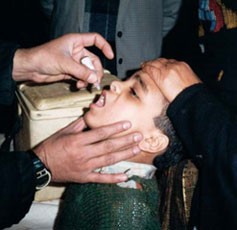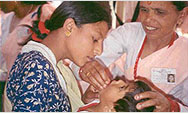USAID Polio Eradication Initiative
The United States plays a leading role in the global campaign to eradicate polio. Since 1996, USAID has allocated more than $200 million to its Polio Eradication Initiative (PEI). In 2002, USAID programmed approximately $27.5 million for polio eradication. USAID’s polio efforts aim to eradicate polio while strengthening the immunization and disease control systems that are essential for child health care in developing countries.

|
| |
View the Photo Documentary on Polio Eradication, taken between 1997 and 2001 by Ellyn W. Ogden, the Worldwide Polio Eradication Coordinator for USAID, while observing national immunization days and other polio activities on behalf of USAID’s Polio Eradication Initiative.
Source: Ellyn W. Ogden/USAID
|
The polio eradication campaign is one of the largest public health initiatives in history and one of the most successful public-private partnerships. In addition to USAID and WHO, the leading “polio partners” include Rotary International, the United Nations Children’s Fund, and the Bill & Melinda Gates Foundation. Private voluntary organizations, nongovernmental organizations, and private sector corporations also participate in the campaign.
Through the PEI, USAID supports national immunization days (NIDs) and other special immunization campaigns that supplement and strengthen routine immunization services. Support includes assistance for advocacy, communications, social mobilization, planning, and the logistics of delivering oral polio vaccine under temperature-controlled conditions. The PEI assists with improvements in polio surveillance, laboratory accreditation, and research into the best ways for supplemental immunization campaigns to reach children in hard-to-reach populations or populations reluctant to accept immunization.
The PEI has six strategies:
- Strengthening partnerships to mobilize resources and coordinate, plan, and implement activities
- Strengthening selected immunization systems at the national and subnational levels to achieve polio eradication, immunization, and other disease control goals
- Supporting supplemental immunizations
- Improving the quality of surveillance and response systems that are integrated with surveillance for other priority diseases
- Supporting certification, containment, and post-certification policy development at all levels
- Improving timely collection and use of information to continuously document the quality of polio eradication, routine immunizations, and diseases of public health importance
The Americas, WHO’s Western Pacific Region (including China), Europe and Eurasia, and parts of Southern and East Africa are now free of wild poliovirus. The remaining pockets of virus transmission are on the Asian subcontinent (Afghanistan, India, and Pakistan); in the Near East and the Horn of Africa (Egypt, Ethiopia, Somalia, and Sudan); and in other areas of Africa (Angola, Niger, and Nigeria). USAID has increased its support for activities in these areas:
- Synchronized multicountry NIDs in 20 West and Central African countries reached more than 96 million children in 2001 and 2002. Subnational immunization days targeting children under age 5 were conducted mainly in countries of East and Southern Africa. In East Africa, five countries participated in coordinated cross-border activities.
- WHO’s South East Asia region, which includes the Indian subcontinent, accounted for almost 80 percent of the global total of polio cases in 2002. Across the region, USAID grants support immunization programs, NIDs, and follow-up campaigns. USAID support helps strengthen planning, surveillance, laboratory training, social mobilization, and information collection activities. In 2002, USAID supported country-specific activities in Bangladesh, India, Indonesia, and Nepal.
In 2002, through the first week of December, 1,120 cases of confirmed poliovirus were reported from seven countries. This number is more than double the 497 cases reported in 2001, largely due to outbreaks in Nigeria and India. Such outbreaks are the result of poor routine and supplemental immunization coverage, which allows poliovirus to persist undetected as the numbers of susceptible children grow. Increased collection, analysis, and use of district-level surveillance data can help identify program areas in need of improvement. To eliminate polio completely, it is more important than ever for the eradication program to reach marginalized populations repeatedly overlooked by vaccinators.
Related Links
|


